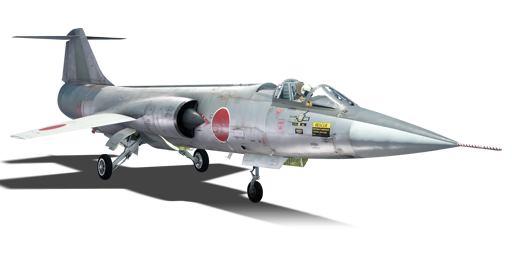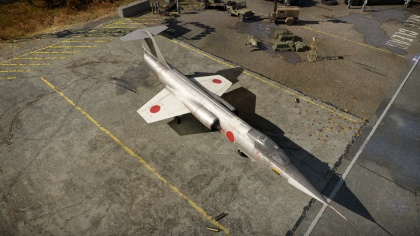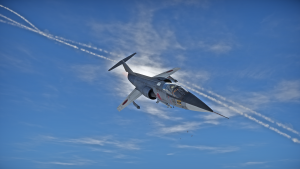F-104J
Contents
| This page is about the jet fighter F-104J. For other versions, see F-104 (Family). |
Description
The F-104J Starfighter is a rank VI Japanese jet fighter
with a battle rating of 10.3 (AB/RB) and 10.0 (SB). It was introduced in Update "Starfighters".
General info
Flight performance
The F-104J's performance can be summarised in one word: speed. For it to work effectively, you must be fast. Below 1,000 km/h, your elevator will be ineffective for any sort of combat manoeuvres. Though it may be helped by the deployment of combat or takeoff flaps as speed allows, even those will not be able to keep up with the other aircraft it faces at its battle rating. This being said, the aircraft is very responsive overall, especially in the roll aspect.
The short wings must be discussed with some nuance. Though they allow for great roll authority, their effectiveness at low speeds is severely limited. Below 6-800 km/h, you will find that level flight is difficult, if not impossible. Due to this, a very high landing speed is required, which amplifies small mistakes. Even with the perfect pilot, landing this aircraft every time is going to be a challenge.
Finally, the aircraft is only fast in a straight line. When turning, it loses significant amounts of speed, often losing any energy advantage it may have had before the turn.
| Characteristics | Max Speed (km/h at 15,240 m) |
Max altitude (metres) |
Turn time (seconds) |
Rate of climb (metres/second) |
Take-off run (metres) | |||
|---|---|---|---|---|---|---|---|---|
| AB | RB | AB | RB | AB | RB | |||
| Stock | ___ | ___ | 16000 | __._ | __._ | __._ | __._ | 850 |
| Upgraded | ___ | ___ | __._ | __._ | __._ | __._ | ||
Details
| Features | |||||
|---|---|---|---|---|---|
| Combat flaps | Take-off flaps | Landing flaps | Air brakes | Arrestor gear | Drogue chute |
| ✓ | ✓ | ✓ | ✓ | ✓ | ✓ |
| Limits | ||||||
|---|---|---|---|---|---|---|
| Wings (km/h) | Gear (km/h) | Flaps (km/h) | Max Static G | |||
| Combat | Take-off | Landing | + | - | ||
| 0 | 546 | 2,350 | 833 | 444 | ~11 | ~4 |
| Optimal velocities (km/h) | |||
|---|---|---|---|
| Ailerons | Rudder | Elevators | Radiator |
| < 720 | < 950 | < 800 | N/A |
Survivability and armour
The aircraft has some survivability, although it should be noted that due to its small size, any hits to the rear of the plane are very likely to cause engine damage, which will be problematic due to the horrible gliding ability of this aircraft. The structure, however, makes it difficult to knock out the pilot from behind. Also, due to the high tail structure, it is easy to destroy the tail entirely, which will result in a near total loss of control. Though the flaps may be utilized to some extent, at lower speeds they will falter, making it very hard to take a damaged aircraft back to the runway.
When a wing is fully lost, the aircraft will suffer from extreme roll which may only be countered by use of the rudder and remaining aileron simultaneously. At this point, the aircraft is practically impossible to land and should be considered lost.
The plane also has no armour protection.
Armaments
Offensive armament
The F-104J is armed with:
- 1 x 20 mm M61 cannon, nose-mounted (750 rpg)
Suspended armament
The F-104J can be outfitted with the following ordnance:
- Without load
- 14 x Hydra-70 M247 rockets
- 2 x AIM-9B Sidewinder missiles
- 2 x AIM-9B Sidewinder missiles + 14 x Hydra-70 M247 rockets
- 2 x AIM-9E Sidewinder missiles
- 2 x AIM-9E Sidewinder missiles + 14 x Hydra-70 M247 rockets
Usage in battles
The F-104J is a difficult aircraft to fly and be competitive in without a doubt. It requires a completely unique set of tactics and manoeuvres that must be utilized without fail, or it will result in a loss. The F-104J should not be intentionally placed in a dog-fighting scenario. In the overwhelming majority of situations, you will lose the engagement due to your inferior mobility at all speeds. Though it is possible to do such things, and it is up to the judgement of the pilot on whether or not it will work out in a win, it is unlikely to happen. Particularly, there are two situations that the pilot should be aware of.
The first is the reversal. Due to the great manoeuvrability advantage of most other aircraft at your battlerating, you will often find yourself with an enemy aircraft behind you in seconds. If you have the energy advantage, do not panic. Chances are, you can successfully escape. However, if not, you should panic because the enemy will likely simply fire air-to-air missiles until your speed is sufficiently reduced to either result in a missile or gun kill.
The second is that of the failure of the classic "boom and zoom" tactic, where the pilot will engage an enemy with less altitude and speed than them, then regain their lost altitude after the attack. This will often fail in this aircraft due to the poorer energy retention in a climb and the fact that you will often be engaged by air-to-air missiles. In this situation, you should wait before the enemy is at a safe distance before resetting your altitude.
Outside of simply keeping speed up, typically above 1,000 km/h, the plane should fly in a straight line as much as possible, as manoeuvring will bleed speed like a medieval plague doctor and further hinder the aircraft's effectiveness in battle.
Overall, when used correctly, the F-104J can be a serious threat to the enemy, though it is easily countered in some situations. The 20 mm cannon is capable with 750 rounds and good impact on target, though the AAM performance is lacklustre compared to its peers, as it receives the same air-to-air loadout as its cousin, the Mitsubishi T-2. Only two missiles of the B and E Sidewinder variants may be carried, in contrast the high performance AIM-9J model that its other export brother, the F-104G possesses. However, without these missiles the aircraft would suffer tremendously.
As such, you should use your missiles only when they are guaranteed a kill, and which a gun kill may not be guaranteed, which is at medium ranges or low energy opponents with a significant altitude difference.
Modules
| Tier | Flight performance | Survivability | Weaponry | ||
|---|---|---|---|---|---|
| I | Fuselage repair | Offensive 20 mm | RL-7 | ||
| II | Compressor | Airframe | New 20 mm cannons | ||
| III | Wings repair | Engine | AIM-9B | ||
| IV | G-suit | Cover | RWR | AIM-9E | |
Pros and cons
Pros:
- Extreme top speed
- Responsive acceleration
Cons:
- Poor manoeuvrability at low and medium speed
- Inadequate AAM
- Lack of a radar gunsight
History
Describe the history of the creation and combat usage of the aircraft in more detail than in the introduction. If the historical reference turns out to be too long, take it to a separate article, taking a link to the article about the vehicle and adding a block "/History" (example: https://wiki.warthunder.com/(Vehicle-name)/History) and add a link to it here using the main template. Be sure to reference text and sources by using <ref></ref>, as well as adding them at the end of the article with <references />. This section may also include the vehicle's dev blog entry (if applicable) and the in-game encyclopedia description (under === In-game description ===, also if applicable).
Media
See also
Links to the articles on the War Thunder Wiki that you think will be useful for the reader, for example:
- reference to the series of the aircraft;
- links to approximate analogues of other nations and research trees.
External links
| Japan jet aircraft | |
|---|---|
| IJNAS | |
| Experimental | Kikka |
| Reconnaissance | R2Y2 Kai V1 · R2Y2 Kai V2 · R2Y2 Kai V3 |
| IJAAS | |
| Fighters | Ki-200 |
| JASDF | |
| Fighters | F-86F-30 ▅ · F-86F-40 ▅ · F-86F-40 JASDF▅ |
| F-104J | |
| F-4EJ Phantom II · F-4EJ ADTW · F-4EJ Kai Phantom II | |
| F-15J · F-15J(M) | |
| F-16AJ | |
| F-1 | |
| Trainers | T-2 Early · T-2 |
| Foreign | |
| Thailand | ▄AV-8S · ▄F-5E FCU |






